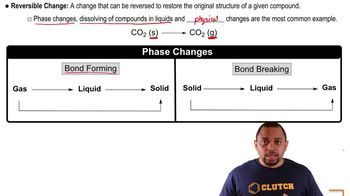The activation energy of an uncatalyzed reaction is 95 kJ/mol. The addition of a catalyst lowers the activation energy to 55 kJ/mol. Assuming that the collision factor remains the same, by what factor will the catalyst increase the rate of the reaction at (a) 25 C
Consider the reaction A + B → C + D. Is each of the following statements true or false? (c) If the reaction is an elementary reaction, the rate law of the reverse reaction is first order.

Verified Solution
Key Concepts
Elementary Reactions

Rate Laws

Reverse Reactions

The activation energy of an uncatalyzed reaction is 95 kJ/mol. The addition of a catalyst lowers the activation energy to 55 kJ/mol. Assuming that the collision factor remains the same, by what factor will the catalyst increase the rate of the reaction at (b) 125 °C?
Consider the reaction A + B → C + D. Is each of the following statements true or false? (b) If the reaction is an elementary reaction, the rate law is second order.
The reaction 2 NO(g) + O2(g) → 2 NO2 (g) is second order in NO and first order in O2. When [NO] = 0.040 M, and 3O24 = 0.035 M, the observed rate of disappearance of NO is 9.3⨉10-5 M/s. (b) What is the value of the rate constant?
The reaction 2 NO(g) + O2(g) → 2 NO2 (g) is second order in NO and first order in O2. When [NO] = 0.040 M, and 3O24 = 0.035 M, the observed rate of disappearance of NO is 9.3⨉10-5 M/s. (c) What are the units of the rate constant?
Consider the following reaction between mercury(II) chloride and oxalate ion: 2 HgCl21aq2 + C2O4 2 - 1aq2¡2 Cl - 1aq2 + 2 CO21g2 + Hg2Cl21s2 The initial rate of this reaction was determined for several concentrations of HgCl2 and C2O4 2 -, and the following rate data were obtained for the rate of disappearance of C2O4 2 - : Experiment 3HgCl2 4 1M 2 3C2o4 24 1M 2 Rate 1M,s2 1 0.164 0.15 3.2 * 10-5 2 0.164 0.45 2.9 * 10-4 3 0.082 0.45 1.4 * 10-4 4 0.246 0.15 4.8 * 10-5 (c) What is the reaction rate when the initial concentration of HgCl2 is 0.100 M and that of C2O4 2- is 0.25 M if the temperature is the same as that used to obtain the data shown?
